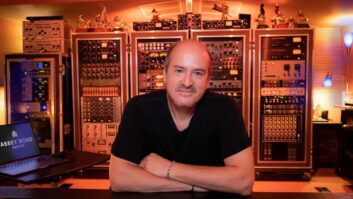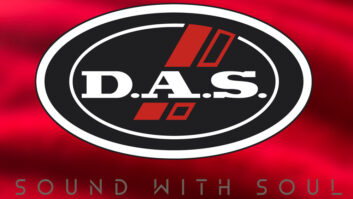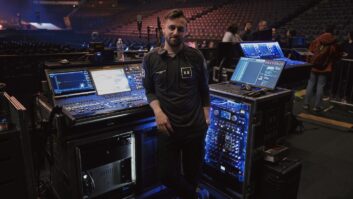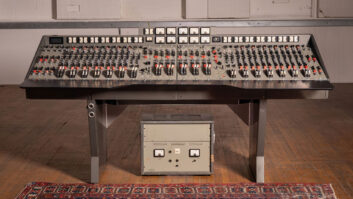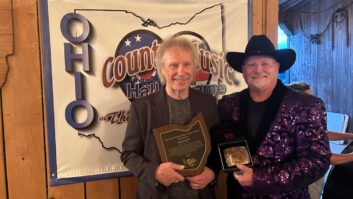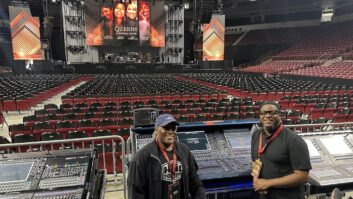Atlanta (October 8, 2008)—Nashville living legend Ronnie Milsap has just released a new CD, My Life, and continues to add his multi-faceted flair to country music on stages across the USA. Along with his various ongoing musical projects and studio work, Milsap seeks out his fans for some 70-80 live dates a year, occasionally serving as the opening act (including on George Strait’s 2007 tour). Milsap always captivates a crowd, and even awes the headliners like Trace Adkins, who Milsap opened for when PSN hopped on the tour bus for a jaunt to Atlanta for a summer time gig at the Chastain Park Amphitheater.
When FOH engineer and production manager Kerry West first joined the Milsap crew in August of 1993, he recalls that Chastain Park, one of the first gigs, was a “candlelit in the park kind of thing”—a magical night that produced a great console tape. Music and technology have changed a lot over the years since those early days. “There’s such a greater potential now to show the audience much more closely the dynamics that are going on on the stage,” says West. He’s become a big fan of line arrays, no longer having to worry about the sound being “five or ten times louder in the front row,” adding that when they are set up right, it’s like “front row seating everywhere—what a joy that you know you are mixing for more than one little tiny slice of people.” The Chastain venue has an L-Acoustic V-Dosc array permanently installed, driven by L-Acoustic, BSS and Dolby Lake processing feeding L-Acoustic and Crown MacroTech amps.
West began his forays into audio at the age of 15 when his electrical engineer father built an early home studio in their home in 1961 (the senior West was also a steel guitar player and built the first “talk box” in his garage, later seen by Joe Walsh, who worked with Bob Heil to commercialize the concept). On the road, West began by driving the bus, his road duties eventually evolving to FOH for his mom, famed Country artist Dottie West. When West began working with Milsap after his mom’s retirement, the tour package was significantly more elaborate than today’s single bus and trailer, comprising a 24’ truck of just band gear and three buses. The band, once eight members strong with additional guitar, steel and keyboard players, is now five players plus Milsap (The star says that his current band is so good, they can still cover a broad range of styles, and only the steel guitar might be missed).
Traveling light these days, West has become a fan of digital consoles, though his history with automation stretches back to using a MIDI-based Yamaha controller to modify external effects before the internal processing and snapshot capabilities of digital desks made carrying processing racks unnecessary. A Yamaha PM5D from Chastain’s Atlanta sound provider, Entertainment Design Group (www.goedg.com), was at FOH for this gig. Yamaha digital desks are the most common West encounters, with the PM5D and the M7CL (used on monitors at Chastain) “pretty universally available,” though he’s also a fan of DiGiCo consoles (where the native processing is “very well done”) and he’s used Digidesign’s Venue offferings, with the only complaint being when the compliment of add-on plugs differs from rented desk to desk.
“The cool thing about these digital consoles,” says West, “is that if you’ve never even seen a desk before, because it’s literally just numbers, you can take the literal numbers of a previous template where you know the gain structure, and apply that to a console you’ve never seen, and be extremely close.” As well as being able to learn a console and configure it with offline software, West says he also appreciates the predictability of digital—not having to worry about worn switches or other problems that can plague an analog console. West would still like to see dynamics processing improved on digital consoles, particularly for the master bus, but says he’s “finally getting along” with digital dynamics and “growing to love” the Yamaha multiband compressor, especially since Version 2 software is allowing it to be inserted, along with other internal effects, on the stereo bus.
For consistency, facing a different console and PA on each gig, West says, “I’m a big fan of doing most of my set-up on headphones in a given show.” While the monitors are being rung out on stage, West gets his basic sounds and his gain structure together in the cans, then turning on the PA “to see how close we’ll be able to translate” to how he knows it should sound, though adding the caveat that, “Bass is probably the biggest thing you can’t translate from headphones.” So that he can selectively mute and mix and match signals he’s monitoring, West says “I’m a big fan of using the matrix outputs of most consoles to drive any signal that needs to leave the console to go to speakers.” This avoids the problem of most desks muting the headphone feed when a main L-R out is muted. He puts his graphic EQ on the matrix outputs for most PA adjustments, and the use of matrixes for feeds also allows him to set the gain structure on his main two mix outputs where he wants them to operate, as he notes that sound systems typically have more gain than necessary.
On monitors is Belmont university faculty member Tony Cottrill. Former Milsap monitor engineer, Kirby Julufka, a former student of Cottrill’s (when Cottrill taught at SAE), “made me happy,” says Milsap. After Julufka moved on, “I went through a slew of monitor engineers,” Milsap continues. “I will say that’s probably one of the hardest jobs out there.” Finally, Milsap asked his son to inquire who had taught Julufka, resulting in the offer to Cottrill to join the crew on their primarily weekend jaunts. That was some 17 months ago, and now it’s Cottrill making Milsap happy, too, with his current Belmont student, Nick Abrahamson, filling in when Cottrill can’t make a given show. The addition of the long-tenured Marty MacKeever, keyboard tech, gives Milsap what he calls his “dream team” for technical support.
Discover more great stories—get a free Mix SmartBrief subscription!
Through an arrangement that put promoter’s rental funds back into Belmont’s audio purchasing budget, and gave him more real world time on the console to translate back to education, Cottrill carried Belmont’s Yamaha M7CL for several of Milsap’s summer gigs, including Chastain. Stage monitoring for the band is comprised of 11 total mixes—five for Milsap alone with his stereo sidefills, different keyboard and singing positions, and a pair of Galaxy Audio Hot Spots on his piano. The Hot Spots are fed by the only outboard processing in the rig—a Presonus Eureka feeding a BSS FCS966 graphic EQ feeding the monitors, which sit in the vocal mic’s null. Milsap controls his own balance and master level on the Hot Spots.
Cottrill uses user defined keys on the M7CL to pull to the center section elements, like the individual monitor mixes, the four mic configuration for an a cappella “Doo Wop” feature of the show, the iPod for walk-in music and so on. Bias Peak is used on a MacBook to playback loops used to enhance a few songs, but the computer is mainly used for running Metric Halo’s Spectrafoo audio analysis tool—a big aid in determining the ringing and feedback frequencies. “Foo” is driven by a B&K omni fed to the laptop via an MXL Microphones’ MicMate inline USB preamp and interface (Cottrill sometimes augments Spectrafoo with Smaart Live 6 from SIA on the PC). Cotrill says the musicians themselves work as effective “human sweep oscillators,” singing a rising tone to help him zero in on offensive frequencies.
Also saved and looped from Peak are various test signals from the AES Nashville Section’s test CD. Cottrill says “I always do a polarity check,” using the positive-only pulse track from the CD to test the wedges for absolute polarity, using the receiver from a Galaxy Audio Cricket test set to check the signal at each speaker. Always working with rented amps and wedges, Cottrill says he often finds a wedge or two out of polarity. Another of his tricks is to use a wide dispersion laser shining from the wedge horn position to verify that the monitor placement is correct to each band member’s head (a tool he’s also found helpful doing speaker placement during church speaker installs).
Most of the combinations of wedges the crew will encounter over the course of the year are programmed into the desk as presets, with a starting point for graphic EQ settings. “That way, when I recall these scenes, the graphs all recall since everything is placed the same,” he explains. Once the aux master fader is set to accommodate for differences in amps, “everything should fall right in place; it comes back the same, minus some minor differences from room acoustics.” On this day, restrictive hours for soundcheck (the park is in the middle of an upscale residential neighborhood) and a rain delay crimped the time allotted for a Milsap soundcheck—Cottrill says if he’d been on an analog desk, he’d have been hard pressed to be ready for show time (not to mention pre-show catering). Internal processing in the monitor path is restricted to EQ and dynamics control, the latter being a bit of instrument compression and a hard limit for Milsap’s monitor volume control. A standard Linksys wireless router and Yamaha’s Studio Manager software let Cottrill also work anywhere in the venue from his hybrid Dell laptop/tablet PC.
All of the main vocal mics are Shure Beta 58s. “There’s some magical thing about the proximity effect of a 58 that lets Ronnie work the mic like he likes to—not too many artists can work a mic like he does and get away with it,” says West, adding that he wants the vocalists to work close and he thinks artists using in-ears tend to back off a bit, while wedges keep them “up close and personal.” Shure SM58s are used for vocals in the Doo Wop segment, while SM57s mic guitarist/band leader/tour manager Jamie Brantley’s guitar amps. More Shures—a combination of SM81s, 91s and 98s—handle drums, with keys, bass and acoustic guitar fed direct.
Brian Matney, a comedian who warms the crowd for Milsap, uses the only wireless microphone (provided by the venue). For outdoor dates like this, Milsap uses a Yamaha digital grand piano (“This is the only piano I ever need,” he opines during soundcheck), along with a combination of keys including a Yamaha DX7’s mono out fed through a vintage Roland Dimension D and processing from TC Electonic, and even, for a certain sound, a MIDI-controlled Alesis Nano piano. West says the band “inherently” gets a well-balanced blend off the stage “and I just make up the difference.” He calls it “old school,” asking “How many engineers can say that? All you need is one player playing too loud off the stage to kind of tie your hands as to what you can do out front [to get] a good balance.”
Milsap calls West their “spiritual leader;” West acknowledges that his job is more than technical (“My job doesn’t start with knowing anything about sound; it’s a people skills business”) and says that fostering the confidence Milsap has in him is something that is a big part of his job: “There’s a people skill dimension” that comes into play “before you ever plug in the first cable.” Milsap pipes in: “I’ll say one thing, Kerry West: When you’re not here, I’m not going to be here—I don’t ever think about it; it’s just total trust.”



